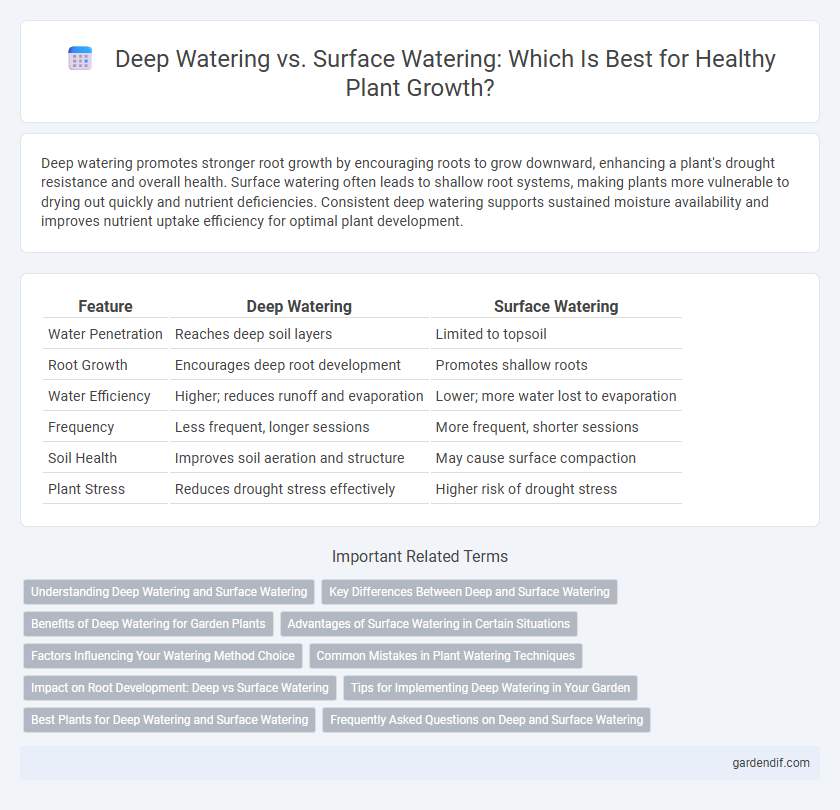
Deep Watering vs Surface Watering Illustration
Deep watering promotes stronger root growth by encouraging roots to grow downward, enhancing a plant's drought resistance and overall health. Surface watering often leads to shallow root systems, making plants more vulnerable to drying out quickly and nutrient deficiencies. Consistent deep watering supports sustained moisture availability and improves nutrient uptake efficiency for optimal plant development.
Table of Comparison
| Feature | Deep Watering | Surface Watering |
|---|---|---|
| Water Penetration | Reaches deep soil layers | Limited to topsoil |
| Root Growth | Encourages deep root development | Promotes shallow roots |
| Water Efficiency | Higher; reduces runoff and evaporation | Lower; more water lost to evaporation |
| Frequency | Less frequent, longer sessions | More frequent, shorter sessions |
| Soil Health | Improves soil aeration and structure | May cause surface compaction |
| Plant Stress | Reduces drought stress effectively | Higher risk of drought stress |
Understanding Deep Watering and Surface Watering
Deep watering penetrates the soil to a depth of 6 to 12 inches, promoting strong root growth and drought resistance in plants. Surface watering typically wets only the top 1 to 2 inches of soil, which encourages shallow roots and increases susceptibility to drying out. Understanding these watering methods helps optimize irrigation practices for healthier, more resilient plants.
Key Differences Between Deep and Surface Watering
Deep watering penetrates the soil to encourage roots to grow deeper, promoting drought resistance and overall plant health. Surface watering only moistens the top layer of soil, often leading to shallow root systems and increased evaporation. Deep watering requires less frequent applications but delivers water more efficiently to the root zone compared to surface watering.
Benefits of Deep Watering for Garden Plants
Deep watering promotes healthier root development by encouraging roots to grow deeper into the soil, improving plant stability and drought resistance. It enhances nutrient absorption and reduces surface evaporation, leading to more efficient water use and increased plant vitality. Garden plants subjected to deep watering exhibit stronger growth and greater resilience against pests and diseases.
Advantages of Surface Watering in Certain Situations
Surface watering promotes quicker absorption by delivering moisture directly to the soil surface, making it ideal for young seedlings and shallow-rooted plants. This method reduces the risk of overwatering and root rot by allowing frequent, controlled hydration. Surface watering also facilitates easy application of fertilizers and soil amendments, enhancing nutrient availability in the upper soil layers.
Factors Influencing Your Watering Method Choice
Soil type and plant species significantly influence the choice between deep watering and surface watering; sandy soils benefit from deep watering to reach roots, while clay soils may require surface watering to prevent waterlogging. Root depth and growth stage also determine watering methods, with deep watering encouraging deep root systems in mature plants, whereas surface watering suits seedlings' shallow roots. Climate conditions such as temperature and rainfall frequency affect irrigation strategies, favoring deep watering during hot, dry periods to maintain moisture below the surface and surface watering in cooler, wetter environments to avoid over-saturation.
Common Mistakes in Plant Watering Techniques
Shallow surface watering often leads to weak root systems as roots remain near the soil surface, increasing plant susceptibility to drought and nutrient deficiency. Deep watering encourages roots to grow deeper into the soil, promoting stronger, more resilient plants, but overwatering can cause root rot and fungal diseases. Frequent, insufficient watering is a common mistake that prevents proper soil moisture absorption, resulting in stress and poor plant development.
Impact on Root Development: Deep vs Surface Watering
Deep watering encourages roots to grow downward, developing a stronger and more extensive root system that enhances the plant's drought resistance and nutrient uptake. Surface watering tends to promote shallow root growth, making plants more vulnerable to environmental stress and less efficient at absorbing water and nutrients. Consistent deep watering supports healthier, more resilient plants by fostering robust root architecture.
Tips for Implementing Deep Watering in Your Garden
Deep watering encourages roots to grow deeper, enhancing drought resistance and nutrient uptake. Use a soaker hose or drip irrigation to deliver water slowly and at root level, reducing evaporation and runoff. Water thoroughly once or twice a week, ensuring the soil is moist at least 12 inches deep to promote strong, healthy root systems.
Best Plants for Deep Watering and Surface Watering
Succulent plants such as aloe vera and agave thrive with deep watering because their extensive root systems access moisture deeply in the soil. Surface watering is ideal for shallow-rooted plants like lettuce and herbs, which absorb water near the soil surface without risk of root rot. Understanding plant root depth and water absorption needs ensures optimal hydration and healthy growth for each species.
Frequently Asked Questions on Deep and Surface Watering
Deep watering promotes extensive root growth by delivering moisture directly to the root zone, which enhances drought resistance and nutrient uptake. Surface watering mainly wets the topsoil, leading to shallow root development and increased evaporation losses, often requiring more frequent irrigation. Gardeners frequently ask how often to deep water, with recommendations typically suggesting once or twice a week depending on soil type and plant species, while surface watering may be needed daily in hot climates or for newly planted seedlings.
Deep Watering vs Surface Watering Infographic

 gardendif.com
gardendif.com